Risk Assessment Report: Analyzing Risks for Tesla Inc. Operations
VerifiedAdded on 2021/06/17
|13
|3755
|563
Report
AI Summary
This comprehensive risk assessment report delves into the multifaceted challenges faced by Tesla Inc., examining its operational, environmental, and economic vulnerabilities. The report begins with background information on Tesla, including its organizational structure, scope of research, and methodology. It then explores environmental risks associated with electric vehicle production and energy sources, considering factors such as battery manufacturing and electricity generation. The assessment also identifies significant economic risks, including dependence on suppliers, production sustainability, fluctuating exchange rates, and the company's history of financial losses. Furthermore, the report analyzes the potential impacts of these risks and offers recommendations for mitigation, providing a thorough overview of Tesla's risk landscape and strategies for business development.
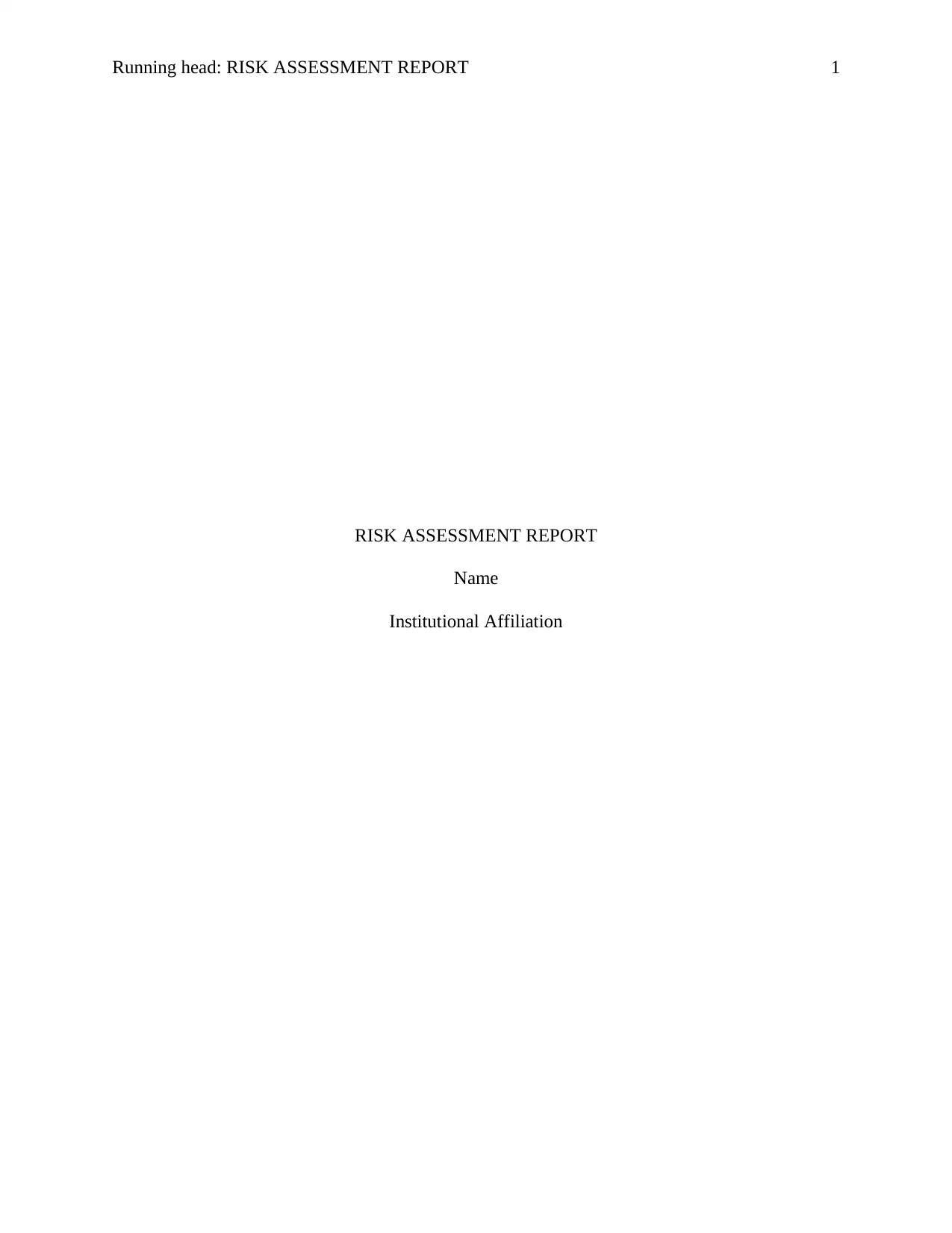
Running head: RISK ASSESSMENT REPORT 1
RISK ASSESSMENT REPORT
Name
Institutional Affiliation
RISK ASSESSMENT REPORT
Name
Institutional Affiliation
Paraphrase This Document
Need a fresh take? Get an instant paraphrase of this document with our AI Paraphraser
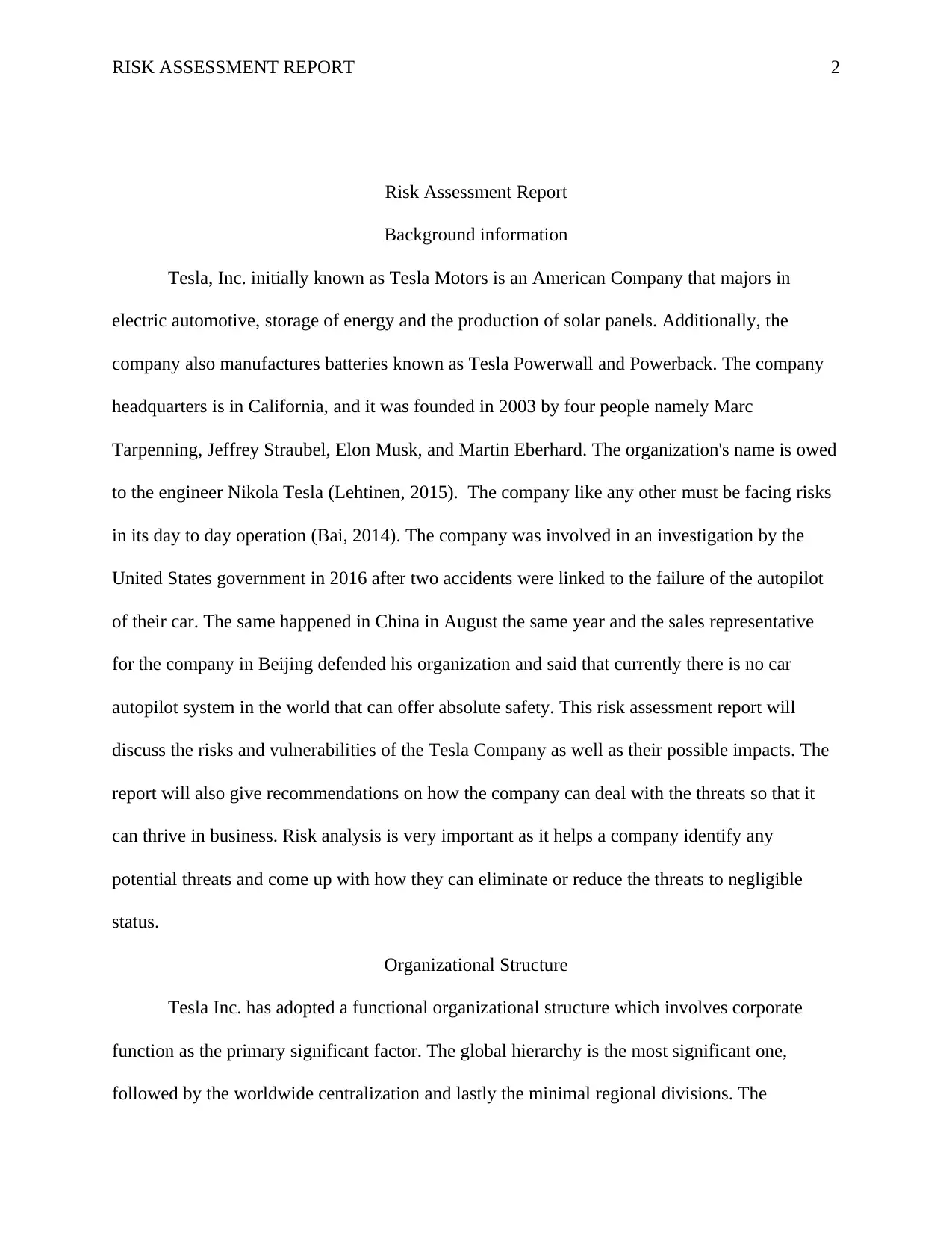
RISK ASSESSMENT REPORT 2
Risk Assessment Report
Background information
Tesla, Inc. initially known as Tesla Motors is an American Company that majors in
electric automotive, storage of energy and the production of solar panels. Additionally, the
company also manufactures batteries known as Tesla Powerwall and Powerback. The company
headquarters is in California, and it was founded in 2003 by four people namely Marc
Tarpenning, Jeffrey Straubel, Elon Musk, and Martin Eberhard. The organization's name is owed
to the engineer Nikola Tesla (Lehtinen, 2015). The company like any other must be facing risks
in its day to day operation (Bai, 2014). The company was involved in an investigation by the
United States government in 2016 after two accidents were linked to the failure of the autopilot
of their car. The same happened in China in August the same year and the sales representative
for the company in Beijing defended his organization and said that currently there is no car
autopilot system in the world that can offer absolute safety. This risk assessment report will
discuss the risks and vulnerabilities of the Tesla Company as well as their possible impacts. The
report will also give recommendations on how the company can deal with the threats so that it
can thrive in business. Risk analysis is very important as it helps a company identify any
potential threats and come up with how they can eliminate or reduce the threats to negligible
status.
Organizational Structure
Tesla Inc. has adopted a functional organizational structure which involves corporate
function as the primary significant factor. The global hierarchy is the most significant one,
followed by the worldwide centralization and lastly the minimal regional divisions. The
Risk Assessment Report
Background information
Tesla, Inc. initially known as Tesla Motors is an American Company that majors in
electric automotive, storage of energy and the production of solar panels. Additionally, the
company also manufactures batteries known as Tesla Powerwall and Powerback. The company
headquarters is in California, and it was founded in 2003 by four people namely Marc
Tarpenning, Jeffrey Straubel, Elon Musk, and Martin Eberhard. The organization's name is owed
to the engineer Nikola Tesla (Lehtinen, 2015). The company like any other must be facing risks
in its day to day operation (Bai, 2014). The company was involved in an investigation by the
United States government in 2016 after two accidents were linked to the failure of the autopilot
of their car. The same happened in China in August the same year and the sales representative
for the company in Beijing defended his organization and said that currently there is no car
autopilot system in the world that can offer absolute safety. This risk assessment report will
discuss the risks and vulnerabilities of the Tesla Company as well as their possible impacts. The
report will also give recommendations on how the company can deal with the threats so that it
can thrive in business. Risk analysis is very important as it helps a company identify any
potential threats and come up with how they can eliminate or reduce the threats to negligible
status.
Organizational Structure
Tesla Inc. has adopted a functional organizational structure which involves corporate
function as the primary significant factor. The global hierarchy is the most significant one,
followed by the worldwide centralization and lastly the minimal regional divisions. The
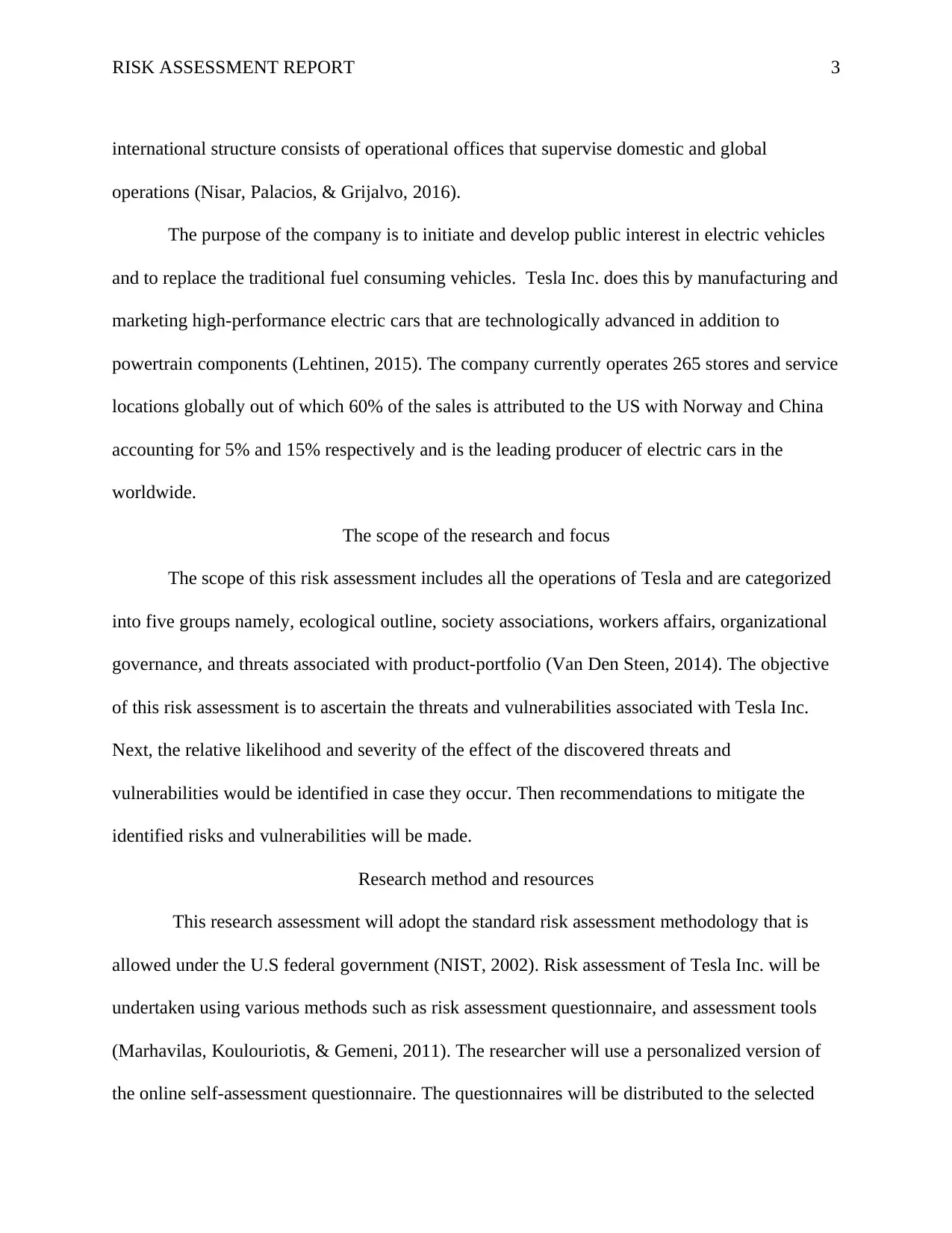
RISK ASSESSMENT REPORT 3
international structure consists of operational offices that supervise domestic and global
operations (Nisar, Palacios, & Grijalvo, 2016).
The purpose of the company is to initiate and develop public interest in electric vehicles
and to replace the traditional fuel consuming vehicles. Tesla Inc. does this by manufacturing and
marketing high-performance electric cars that are technologically advanced in addition to
powertrain components (Lehtinen, 2015). The company currently operates 265 stores and service
locations globally out of which 60% of the sales is attributed to the US with Norway and China
accounting for 5% and 15% respectively and is the leading producer of electric cars in the
worldwide.
The scope of the research and focus
The scope of this risk assessment includes all the operations of Tesla and are categorized
into five groups namely, ecological outline, society associations, workers affairs, organizational
governance, and threats associated with product-portfolio (Van Den Steen, 2014). The objective
of this risk assessment is to ascertain the threats and vulnerabilities associated with Tesla Inc.
Next, the relative likelihood and severity of the effect of the discovered threats and
vulnerabilities would be identified in case they occur. Then recommendations to mitigate the
identified risks and vulnerabilities will be made.
Research method and resources
This research assessment will adopt the standard risk assessment methodology that is
allowed under the U.S federal government (NIST, 2002). Risk assessment of Tesla Inc. will be
undertaken using various methods such as risk assessment questionnaire, and assessment tools
(Marhavilas, Koulouriotis, & Gemeni, 2011). The researcher will use a personalized version of
the online self-assessment questionnaire. The questionnaires will be distributed to the selected
international structure consists of operational offices that supervise domestic and global
operations (Nisar, Palacios, & Grijalvo, 2016).
The purpose of the company is to initiate and develop public interest in electric vehicles
and to replace the traditional fuel consuming vehicles. Tesla Inc. does this by manufacturing and
marketing high-performance electric cars that are technologically advanced in addition to
powertrain components (Lehtinen, 2015). The company currently operates 265 stores and service
locations globally out of which 60% of the sales is attributed to the US with Norway and China
accounting for 5% and 15% respectively and is the leading producer of electric cars in the
worldwide.
The scope of the research and focus
The scope of this risk assessment includes all the operations of Tesla and are categorized
into five groups namely, ecological outline, society associations, workers affairs, organizational
governance, and threats associated with product-portfolio (Van Den Steen, 2014). The objective
of this risk assessment is to ascertain the threats and vulnerabilities associated with Tesla Inc.
Next, the relative likelihood and severity of the effect of the discovered threats and
vulnerabilities would be identified in case they occur. Then recommendations to mitigate the
identified risks and vulnerabilities will be made.
Research method and resources
This research assessment will adopt the standard risk assessment methodology that is
allowed under the U.S federal government (NIST, 2002). Risk assessment of Tesla Inc. will be
undertaken using various methods such as risk assessment questionnaire, and assessment tools
(Marhavilas, Koulouriotis, & Gemeni, 2011). The researcher will use a personalized version of
the online self-assessment questionnaire. The questionnaires will be distributed to the selected
⊘ This is a preview!⊘
Do you want full access?
Subscribe today to unlock all pages.

Trusted by 1+ million students worldwide
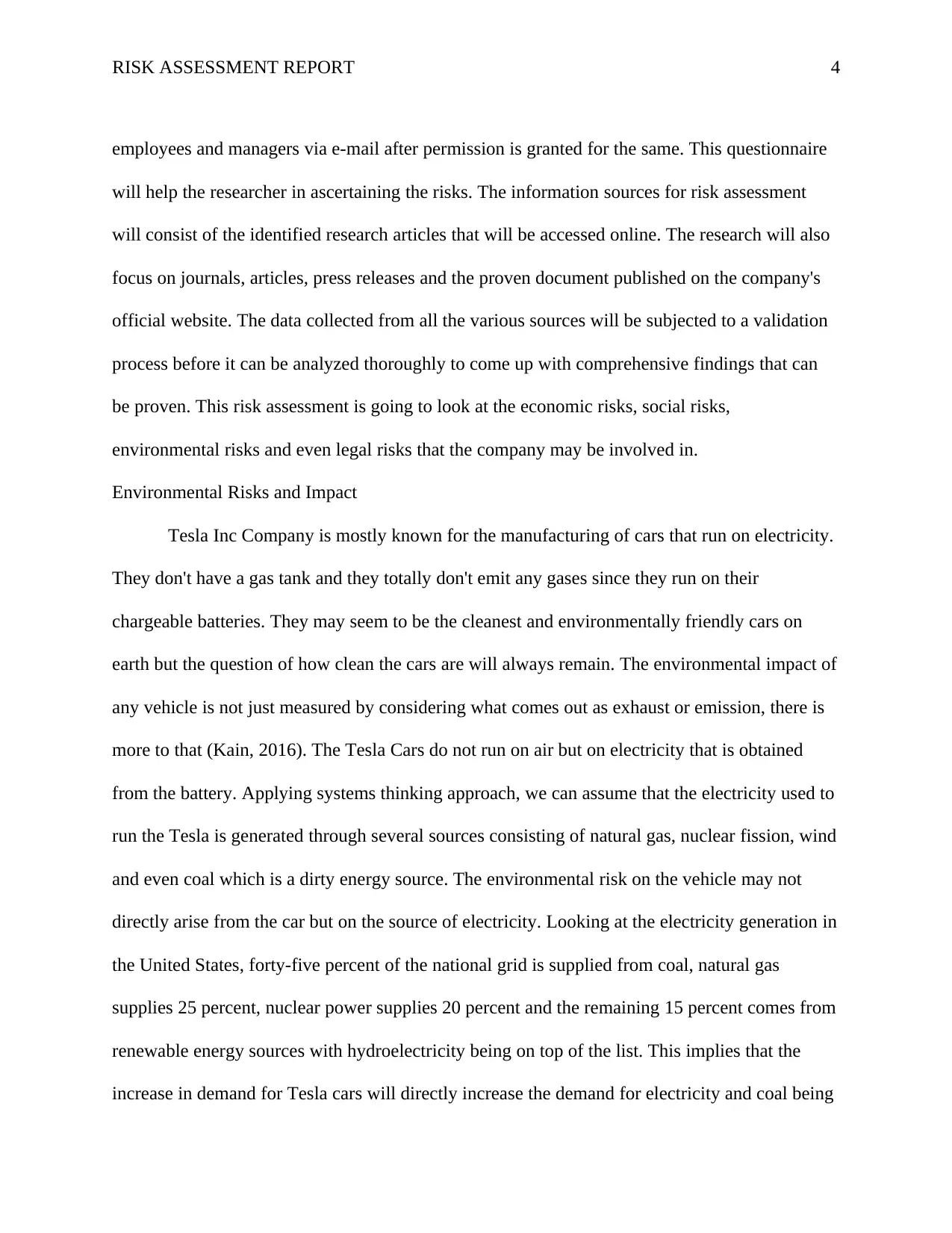
RISK ASSESSMENT REPORT 4
employees and managers via e-mail after permission is granted for the same. This questionnaire
will help the researcher in ascertaining the risks. The information sources for risk assessment
will consist of the identified research articles that will be accessed online. The research will also
focus on journals, articles, press releases and the proven document published on the company's
official website. The data collected from all the various sources will be subjected to a validation
process before it can be analyzed thoroughly to come up with comprehensive findings that can
be proven. This risk assessment is going to look at the economic risks, social risks,
environmental risks and even legal risks that the company may be involved in.
Environmental Risks and Impact
Tesla Inc Company is mostly known for the manufacturing of cars that run on electricity.
They don't have a gas tank and they totally don't emit any gases since they run on their
chargeable batteries. They may seem to be the cleanest and environmentally friendly cars on
earth but the question of how clean the cars are will always remain. The environmental impact of
any vehicle is not just measured by considering what comes out as exhaust or emission, there is
more to that (Kain, 2016). The Tesla Cars do not run on air but on electricity that is obtained
from the battery. Applying systems thinking approach, we can assume that the electricity used to
run the Tesla is generated through several sources consisting of natural gas, nuclear fission, wind
and even coal which is a dirty energy source. The environmental risk on the vehicle may not
directly arise from the car but on the source of electricity. Looking at the electricity generation in
the United States, forty-five percent of the national grid is supplied from coal, natural gas
supplies 25 percent, nuclear power supplies 20 percent and the remaining 15 percent comes from
renewable energy sources with hydroelectricity being on top of the list. This implies that the
increase in demand for Tesla cars will directly increase the demand for electricity and coal being
employees and managers via e-mail after permission is granted for the same. This questionnaire
will help the researcher in ascertaining the risks. The information sources for risk assessment
will consist of the identified research articles that will be accessed online. The research will also
focus on journals, articles, press releases and the proven document published on the company's
official website. The data collected from all the various sources will be subjected to a validation
process before it can be analyzed thoroughly to come up with comprehensive findings that can
be proven. This risk assessment is going to look at the economic risks, social risks,
environmental risks and even legal risks that the company may be involved in.
Environmental Risks and Impact
Tesla Inc Company is mostly known for the manufacturing of cars that run on electricity.
They don't have a gas tank and they totally don't emit any gases since they run on their
chargeable batteries. They may seem to be the cleanest and environmentally friendly cars on
earth but the question of how clean the cars are will always remain. The environmental impact of
any vehicle is not just measured by considering what comes out as exhaust or emission, there is
more to that (Kain, 2016). The Tesla Cars do not run on air but on electricity that is obtained
from the battery. Applying systems thinking approach, we can assume that the electricity used to
run the Tesla is generated through several sources consisting of natural gas, nuclear fission, wind
and even coal which is a dirty energy source. The environmental risk on the vehicle may not
directly arise from the car but on the source of electricity. Looking at the electricity generation in
the United States, forty-five percent of the national grid is supplied from coal, natural gas
supplies 25 percent, nuclear power supplies 20 percent and the remaining 15 percent comes from
renewable energy sources with hydroelectricity being on top of the list. This implies that the
increase in demand for Tesla cars will directly increase the demand for electricity and coal being
Paraphrase This Document
Need a fresh take? Get an instant paraphrase of this document with our AI Paraphraser
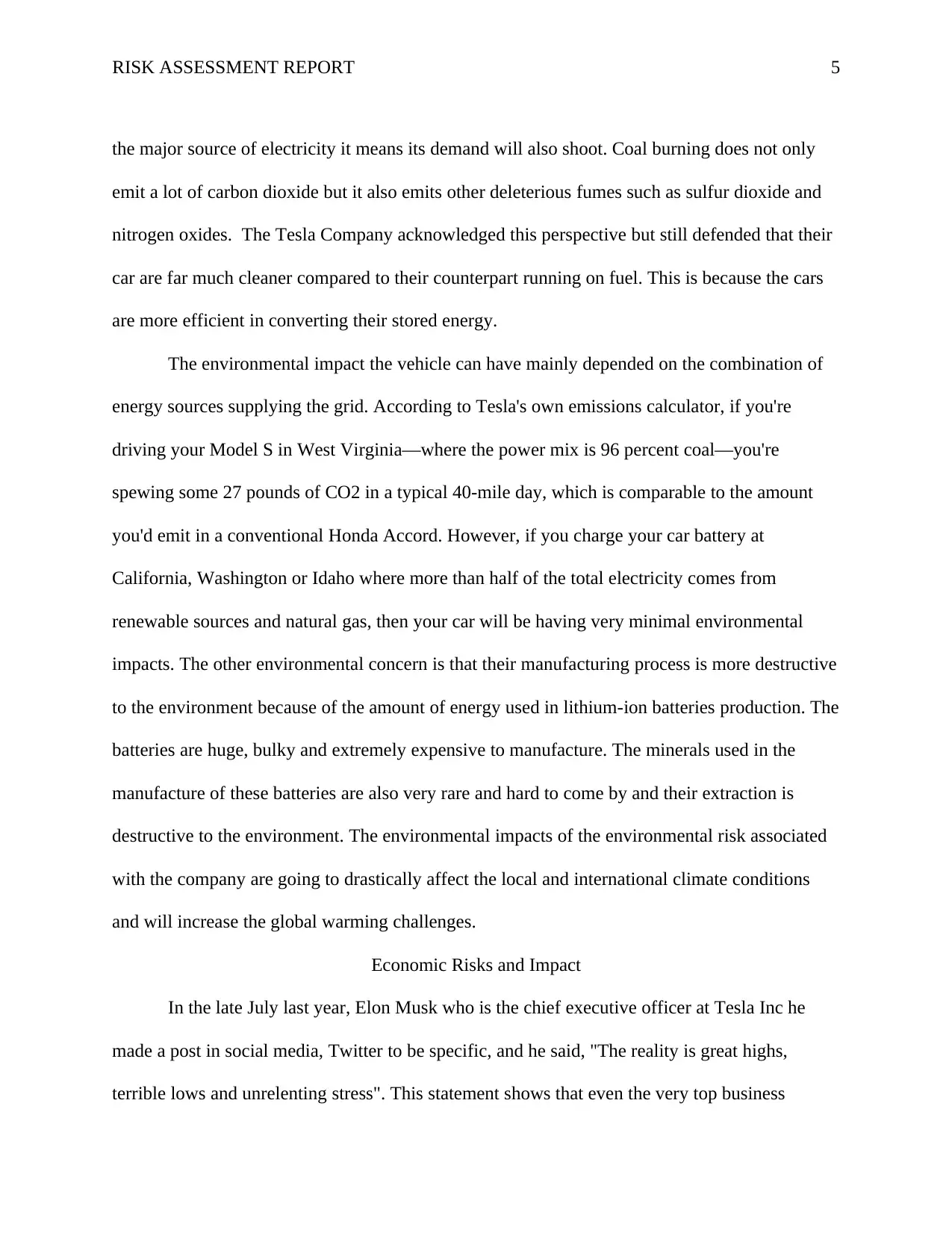
RISK ASSESSMENT REPORT 5
the major source of electricity it means its demand will also shoot. Coal burning does not only
emit a lot of carbon dioxide but it also emits other deleterious fumes such as sulfur dioxide and
nitrogen oxides. The Tesla Company acknowledged this perspective but still defended that their
car are far much cleaner compared to their counterpart running on fuel. This is because the cars
are more efficient in converting their stored energy.
The environmental impact the vehicle can have mainly depended on the combination of
energy sources supplying the grid. According to Tesla's own emissions calculator, if you're
driving your Model S in West Virginia—where the power mix is 96 percent coal—you're
spewing some 27 pounds of CO2 in a typical 40-mile day, which is comparable to the amount
you'd emit in a conventional Honda Accord. However, if you charge your car battery at
California, Washington or Idaho where more than half of the total electricity comes from
renewable sources and natural gas, then your car will be having very minimal environmental
impacts. The other environmental concern is that their manufacturing process is more destructive
to the environment because of the amount of energy used in lithium-ion batteries production. The
batteries are huge, bulky and extremely expensive to manufacture. The minerals used in the
manufacture of these batteries are also very rare and hard to come by and their extraction is
destructive to the environment. The environmental impacts of the environmental risk associated
with the company are going to drastically affect the local and international climate conditions
and will increase the global warming challenges.
Economic Risks and Impact
In the late July last year, Elon Musk who is the chief executive officer at Tesla Inc he
made a post in social media, Twitter to be specific, and he said, "The reality is great highs,
terrible lows and unrelenting stress". This statement shows that even the very top business
the major source of electricity it means its demand will also shoot. Coal burning does not only
emit a lot of carbon dioxide but it also emits other deleterious fumes such as sulfur dioxide and
nitrogen oxides. The Tesla Company acknowledged this perspective but still defended that their
car are far much cleaner compared to their counterpart running on fuel. This is because the cars
are more efficient in converting their stored energy.
The environmental impact the vehicle can have mainly depended on the combination of
energy sources supplying the grid. According to Tesla's own emissions calculator, if you're
driving your Model S in West Virginia—where the power mix is 96 percent coal—you're
spewing some 27 pounds of CO2 in a typical 40-mile day, which is comparable to the amount
you'd emit in a conventional Honda Accord. However, if you charge your car battery at
California, Washington or Idaho where more than half of the total electricity comes from
renewable sources and natural gas, then your car will be having very minimal environmental
impacts. The other environmental concern is that their manufacturing process is more destructive
to the environment because of the amount of energy used in lithium-ion batteries production. The
batteries are huge, bulky and extremely expensive to manufacture. The minerals used in the
manufacture of these batteries are also very rare and hard to come by and their extraction is
destructive to the environment. The environmental impacts of the environmental risk associated
with the company are going to drastically affect the local and international climate conditions
and will increase the global warming challenges.
Economic Risks and Impact
In the late July last year, Elon Musk who is the chief executive officer at Tesla Inc he
made a post in social media, Twitter to be specific, and he said, "The reality is great highs,
terrible lows and unrelenting stress". This statement shows that even the very top business
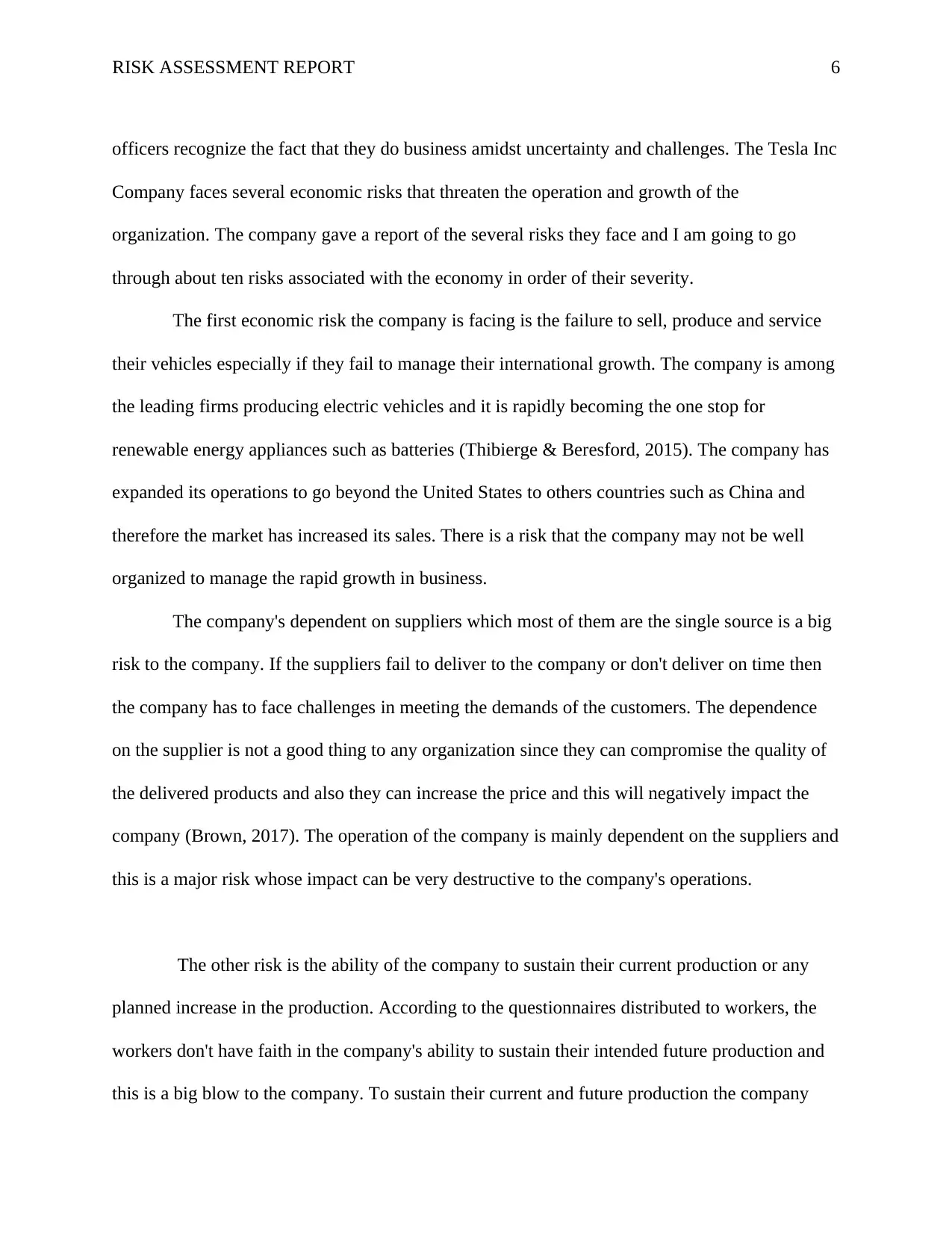
RISK ASSESSMENT REPORT 6
officers recognize the fact that they do business amidst uncertainty and challenges. The Tesla Inc
Company faces several economic risks that threaten the operation and growth of the
organization. The company gave a report of the several risks they face and I am going to go
through about ten risks associated with the economy in order of their severity.
The first economic risk the company is facing is the failure to sell, produce and service
their vehicles especially if they fail to manage their international growth. The company is among
the leading firms producing electric vehicles and it is rapidly becoming the one stop for
renewable energy appliances such as batteries (Thibierge & Beresford, 2015). The company has
expanded its operations to go beyond the United States to others countries such as China and
therefore the market has increased its sales. There is a risk that the company may not be well
organized to manage the rapid growth in business.
The company's dependent on suppliers which most of them are the single source is a big
risk to the company. If the suppliers fail to deliver to the company or don't deliver on time then
the company has to face challenges in meeting the demands of the customers. The dependence
on the supplier is not a good thing to any organization since they can compromise the quality of
the delivered products and also they can increase the price and this will negatively impact the
company (Brown, 2017). The operation of the company is mainly dependent on the suppliers and
this is a major risk whose impact can be very destructive to the company's operations.
The other risk is the ability of the company to sustain their current production or any
planned increase in the production. According to the questionnaires distributed to workers, the
workers don't have faith in the company's ability to sustain their intended future production and
this is a big blow to the company. To sustain their current and future production the company
officers recognize the fact that they do business amidst uncertainty and challenges. The Tesla Inc
Company faces several economic risks that threaten the operation and growth of the
organization. The company gave a report of the several risks they face and I am going to go
through about ten risks associated with the economy in order of their severity.
The first economic risk the company is facing is the failure to sell, produce and service
their vehicles especially if they fail to manage their international growth. The company is among
the leading firms producing electric vehicles and it is rapidly becoming the one stop for
renewable energy appliances such as batteries (Thibierge & Beresford, 2015). The company has
expanded its operations to go beyond the United States to others countries such as China and
therefore the market has increased its sales. There is a risk that the company may not be well
organized to manage the rapid growth in business.
The company's dependent on suppliers which most of them are the single source is a big
risk to the company. If the suppliers fail to deliver to the company or don't deliver on time then
the company has to face challenges in meeting the demands of the customers. The dependence
on the supplier is not a good thing to any organization since they can compromise the quality of
the delivered products and also they can increase the price and this will negatively impact the
company (Brown, 2017). The operation of the company is mainly dependent on the suppliers and
this is a major risk whose impact can be very destructive to the company's operations.
The other risk is the ability of the company to sustain their current production or any
planned increase in the production. According to the questionnaires distributed to workers, the
workers don't have faith in the company's ability to sustain their intended future production and
this is a big blow to the company. To sustain their current and future production the company
⊘ This is a preview!⊘
Do you want full access?
Subscribe today to unlock all pages.

Trusted by 1+ million students worldwide
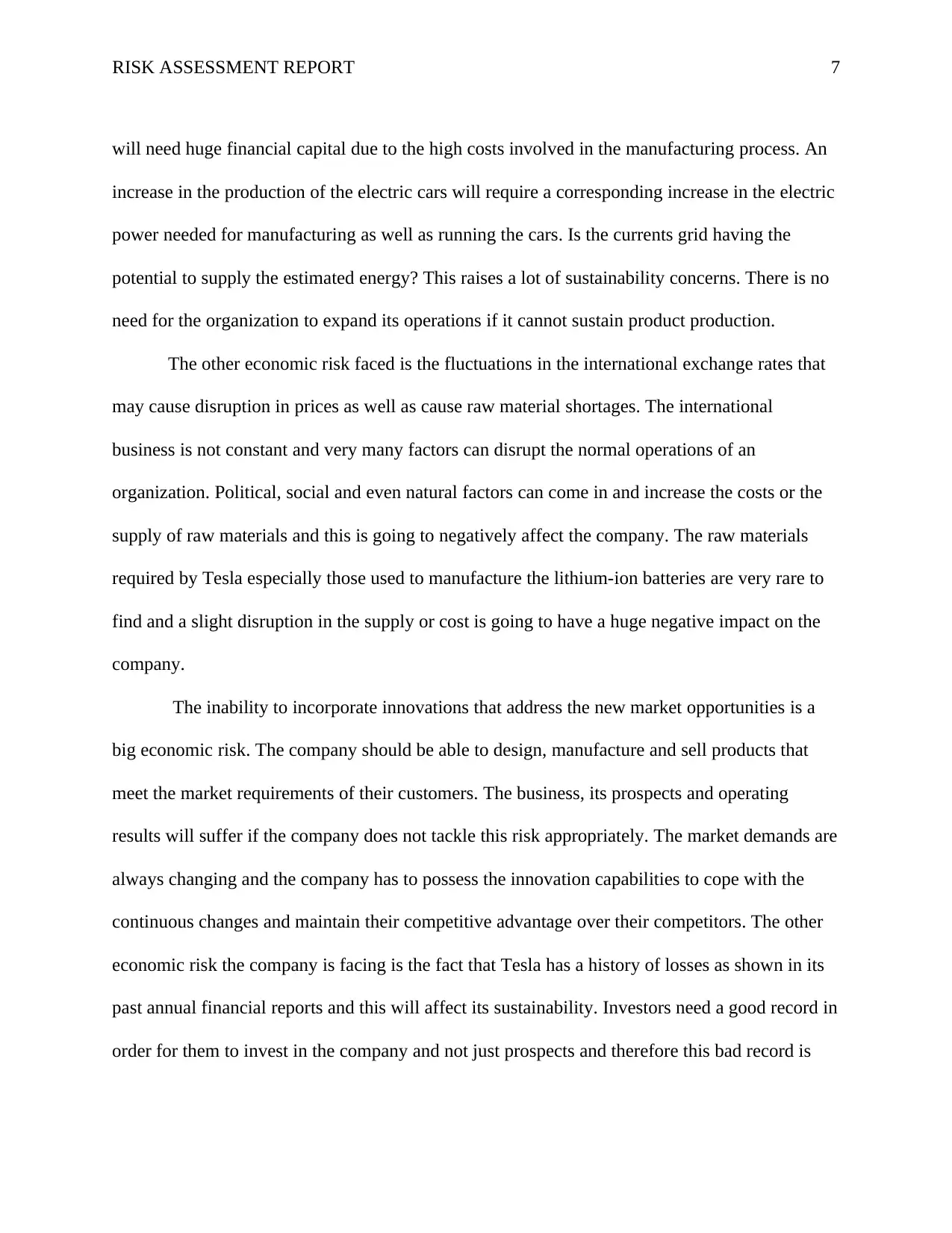
RISK ASSESSMENT REPORT 7
will need huge financial capital due to the high costs involved in the manufacturing process. An
increase in the production of the electric cars will require a corresponding increase in the electric
power needed for manufacturing as well as running the cars. Is the currents grid having the
potential to supply the estimated energy? This raises a lot of sustainability concerns. There is no
need for the organization to expand its operations if it cannot sustain product production.
The other economic risk faced is the fluctuations in the international exchange rates that
may cause disruption in prices as well as cause raw material shortages. The international
business is not constant and very many factors can disrupt the normal operations of an
organization. Political, social and even natural factors can come in and increase the costs or the
supply of raw materials and this is going to negatively affect the company. The raw materials
required by Tesla especially those used to manufacture the lithium-ion batteries are very rare to
find and a slight disruption in the supply or cost is going to have a huge negative impact on the
company.
The inability to incorporate innovations that address the new market opportunities is a
big economic risk. The company should be able to design, manufacture and sell products that
meet the market requirements of their customers. The business, its prospects and operating
results will suffer if the company does not tackle this risk appropriately. The market demands are
always changing and the company has to possess the innovation capabilities to cope with the
continuous changes and maintain their competitive advantage over their competitors. The other
economic risk the company is facing is the fact that Tesla has a history of losses as shown in its
past annual financial reports and this will affect its sustainability. Investors need a good record in
order for them to invest in the company and not just prospects and therefore this bad record is
will need huge financial capital due to the high costs involved in the manufacturing process. An
increase in the production of the electric cars will require a corresponding increase in the electric
power needed for manufacturing as well as running the cars. Is the currents grid having the
potential to supply the estimated energy? This raises a lot of sustainability concerns. There is no
need for the organization to expand its operations if it cannot sustain product production.
The other economic risk faced is the fluctuations in the international exchange rates that
may cause disruption in prices as well as cause raw material shortages. The international
business is not constant and very many factors can disrupt the normal operations of an
organization. Political, social and even natural factors can come in and increase the costs or the
supply of raw materials and this is going to negatively affect the company. The raw materials
required by Tesla especially those used to manufacture the lithium-ion batteries are very rare to
find and a slight disruption in the supply or cost is going to have a huge negative impact on the
company.
The inability to incorporate innovations that address the new market opportunities is a
big economic risk. The company should be able to design, manufacture and sell products that
meet the market requirements of their customers. The business, its prospects and operating
results will suffer if the company does not tackle this risk appropriately. The market demands are
always changing and the company has to possess the innovation capabilities to cope with the
continuous changes and maintain their competitive advantage over their competitors. The other
economic risk the company is facing is the fact that Tesla has a history of losses as shown in its
past annual financial reports and this will affect its sustainability. Investors need a good record in
order for them to invest in the company and not just prospects and therefore this bad record is
Paraphrase This Document
Need a fresh take? Get an instant paraphrase of this document with our AI Paraphraser
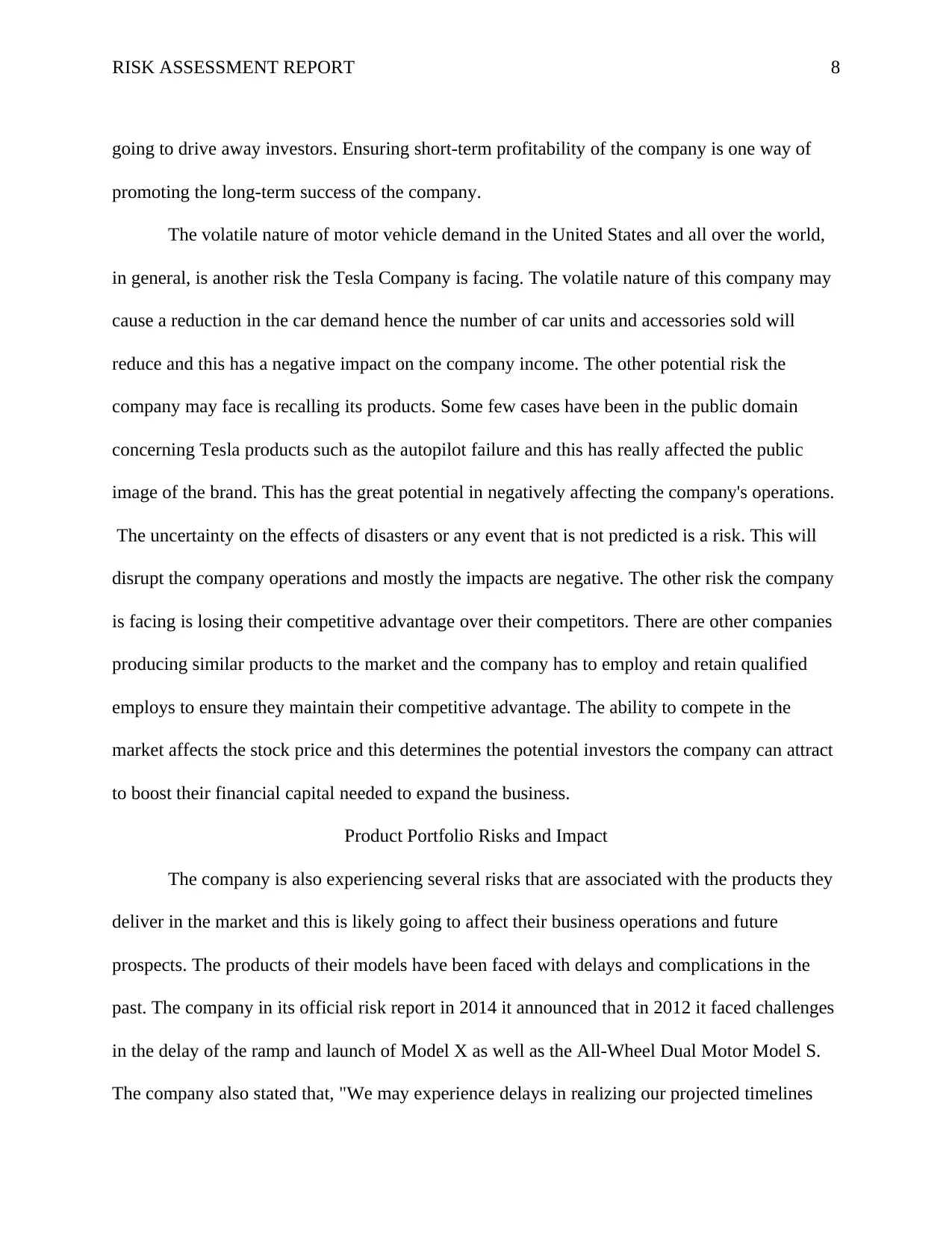
RISK ASSESSMENT REPORT 8
going to drive away investors. Ensuring short-term profitability of the company is one way of
promoting the long-term success of the company.
The volatile nature of motor vehicle demand in the United States and all over the world,
in general, is another risk the Tesla Company is facing. The volatile nature of this company may
cause a reduction in the car demand hence the number of car units and accessories sold will
reduce and this has a negative impact on the company income. The other potential risk the
company may face is recalling its products. Some few cases have been in the public domain
concerning Tesla products such as the autopilot failure and this has really affected the public
image of the brand. This has the great potential in negatively affecting the company's operations.
The uncertainty on the effects of disasters or any event that is not predicted is a risk. This will
disrupt the company operations and mostly the impacts are negative. The other risk the company
is facing is losing their competitive advantage over their competitors. There are other companies
producing similar products to the market and the company has to employ and retain qualified
employs to ensure they maintain their competitive advantage. The ability to compete in the
market affects the stock price and this determines the potential investors the company can attract
to boost their financial capital needed to expand the business.
Product Portfolio Risks and Impact
The company is also experiencing several risks that are associated with the products they
deliver in the market and this is likely going to affect their business operations and future
prospects. The products of their models have been faced with delays and complications in the
past. The company in its official risk report in 2014 it announced that in 2012 it faced challenges
in the delay of the ramp and launch of Model X as well as the All-Wheel Dual Motor Model S.
The company also stated that, "We may experience delays in realizing our projected timelines
going to drive away investors. Ensuring short-term profitability of the company is one way of
promoting the long-term success of the company.
The volatile nature of motor vehicle demand in the United States and all over the world,
in general, is another risk the Tesla Company is facing. The volatile nature of this company may
cause a reduction in the car demand hence the number of car units and accessories sold will
reduce and this has a negative impact on the company income. The other potential risk the
company may face is recalling its products. Some few cases have been in the public domain
concerning Tesla products such as the autopilot failure and this has really affected the public
image of the brand. This has the great potential in negatively affecting the company's operations.
The uncertainty on the effects of disasters or any event that is not predicted is a risk. This will
disrupt the company operations and mostly the impacts are negative. The other risk the company
is facing is losing their competitive advantage over their competitors. There are other companies
producing similar products to the market and the company has to employ and retain qualified
employs to ensure they maintain their competitive advantage. The ability to compete in the
market affects the stock price and this determines the potential investors the company can attract
to boost their financial capital needed to expand the business.
Product Portfolio Risks and Impact
The company is also experiencing several risks that are associated with the products they
deliver in the market and this is likely going to affect their business operations and future
prospects. The products of their models have been faced with delays and complications in the
past. The company in its official risk report in 2014 it announced that in 2012 it faced challenges
in the delay of the ramp and launch of Model X as well as the All-Wheel Dual Motor Model S.
The company also stated that, "We may experience delays in realizing our projected timelines
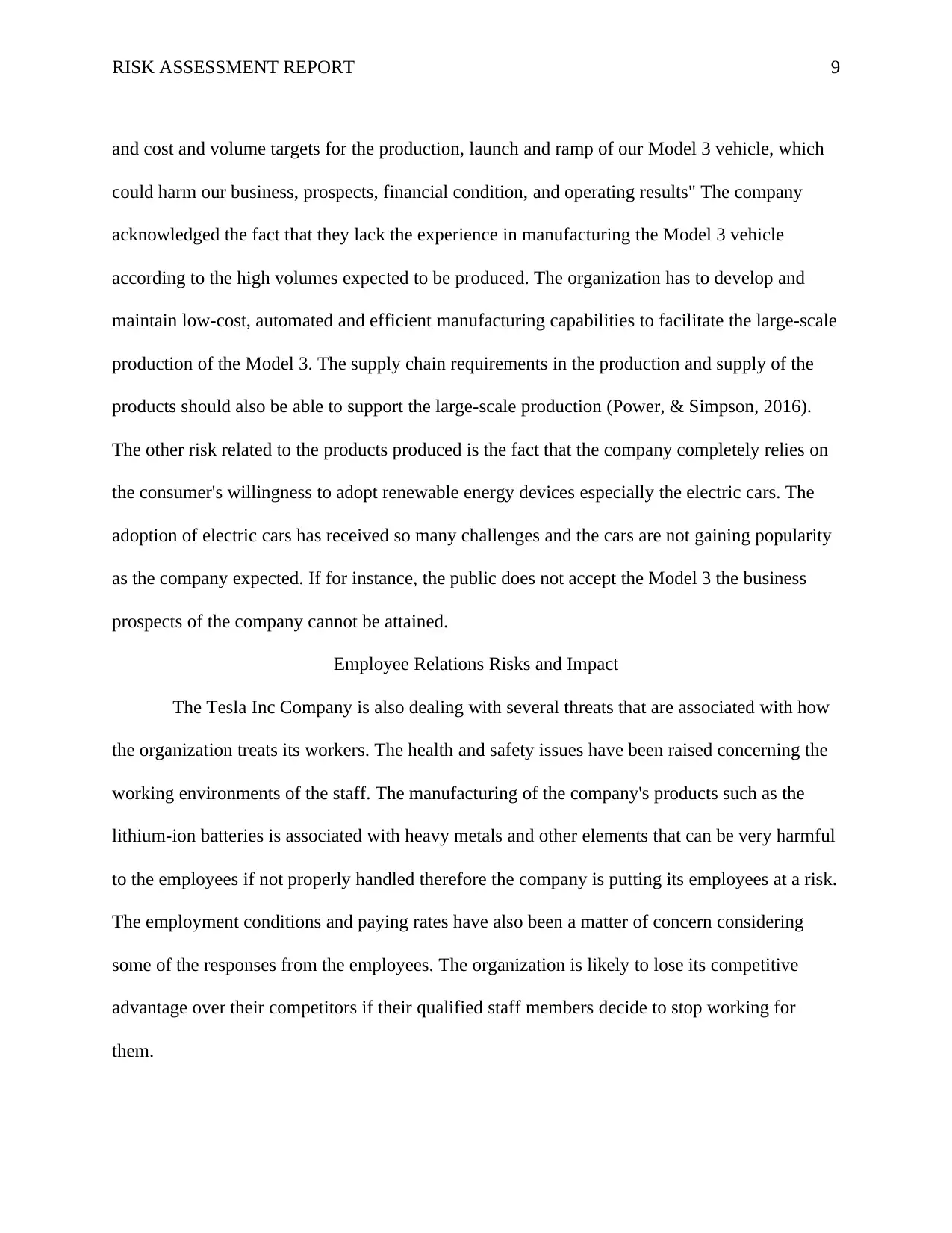
RISK ASSESSMENT REPORT 9
and cost and volume targets for the production, launch and ramp of our Model 3 vehicle, which
could harm our business, prospects, financial condition, and operating results" The company
acknowledged the fact that they lack the experience in manufacturing the Model 3 vehicle
according to the high volumes expected to be produced. The organization has to develop and
maintain low-cost, automated and efficient manufacturing capabilities to facilitate the large-scale
production of the Model 3. The supply chain requirements in the production and supply of the
products should also be able to support the large-scale production (Power, & Simpson, 2016).
The other risk related to the products produced is the fact that the company completely relies on
the consumer's willingness to adopt renewable energy devices especially the electric cars. The
adoption of electric cars has received so many challenges and the cars are not gaining popularity
as the company expected. If for instance, the public does not accept the Model 3 the business
prospects of the company cannot be attained.
Employee Relations Risks and Impact
The Tesla Inc Company is also dealing with several threats that are associated with how
the organization treats its workers. The health and safety issues have been raised concerning the
working environments of the staff. The manufacturing of the company's products such as the
lithium-ion batteries is associated with heavy metals and other elements that can be very harmful
to the employees if not properly handled therefore the company is putting its employees at a risk.
The employment conditions and paying rates have also been a matter of concern considering
some of the responses from the employees. The organization is likely to lose its competitive
advantage over their competitors if their qualified staff members decide to stop working for
them.
and cost and volume targets for the production, launch and ramp of our Model 3 vehicle, which
could harm our business, prospects, financial condition, and operating results" The company
acknowledged the fact that they lack the experience in manufacturing the Model 3 vehicle
according to the high volumes expected to be produced. The organization has to develop and
maintain low-cost, automated and efficient manufacturing capabilities to facilitate the large-scale
production of the Model 3. The supply chain requirements in the production and supply of the
products should also be able to support the large-scale production (Power, & Simpson, 2016).
The other risk related to the products produced is the fact that the company completely relies on
the consumer's willingness to adopt renewable energy devices especially the electric cars. The
adoption of electric cars has received so many challenges and the cars are not gaining popularity
as the company expected. If for instance, the public does not accept the Model 3 the business
prospects of the company cannot be attained.
Employee Relations Risks and Impact
The Tesla Inc Company is also dealing with several threats that are associated with how
the organization treats its workers. The health and safety issues have been raised concerning the
working environments of the staff. The manufacturing of the company's products such as the
lithium-ion batteries is associated with heavy metals and other elements that can be very harmful
to the employees if not properly handled therefore the company is putting its employees at a risk.
The employment conditions and paying rates have also been a matter of concern considering
some of the responses from the employees. The organization is likely to lose its competitive
advantage over their competitors if their qualified staff members decide to stop working for
them.
⊘ This is a preview!⊘
Do you want full access?
Subscribe today to unlock all pages.

Trusted by 1+ million students worldwide
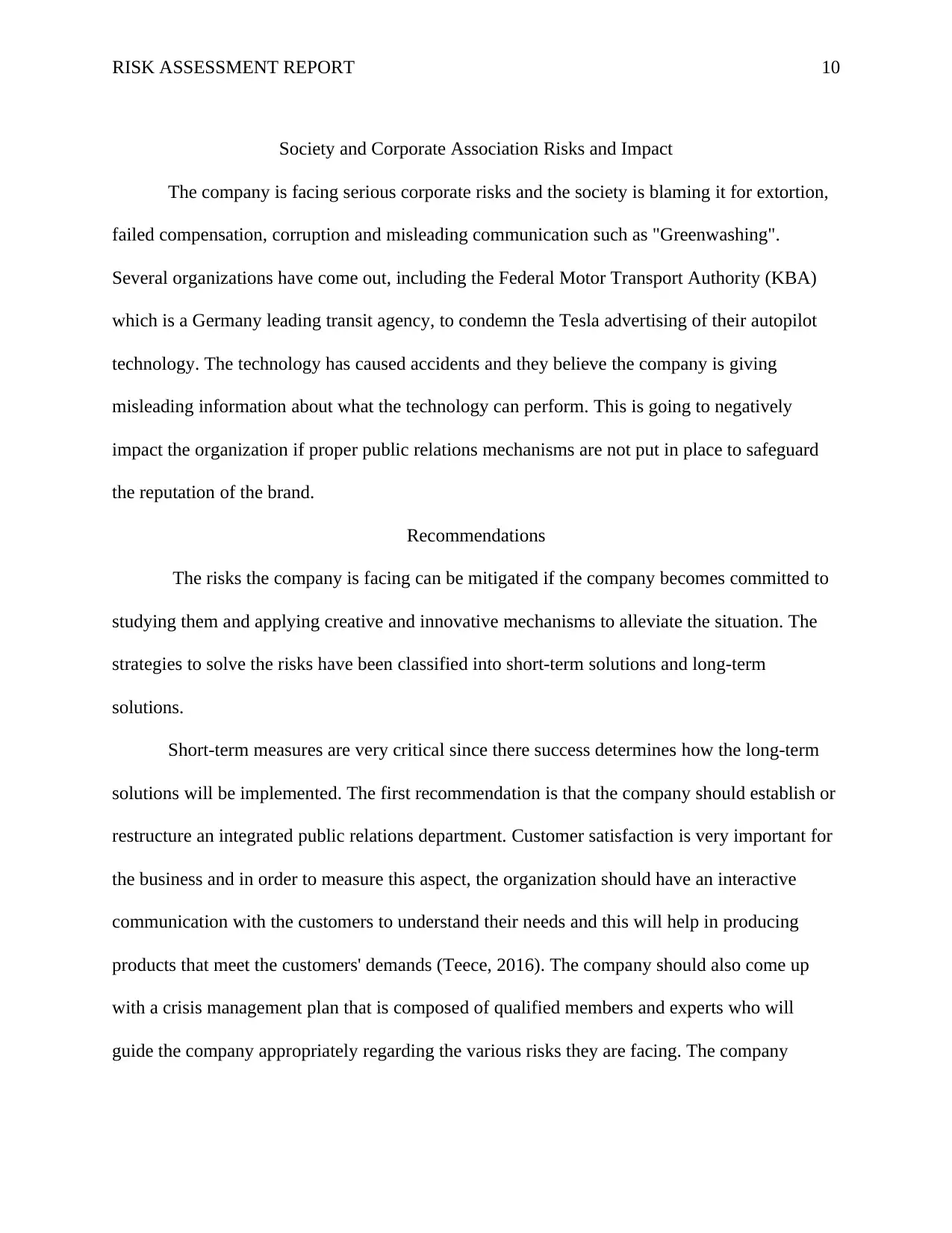
RISK ASSESSMENT REPORT 10
Society and Corporate Association Risks and Impact
The company is facing serious corporate risks and the society is blaming it for extortion,
failed compensation, corruption and misleading communication such as "Greenwashing".
Several organizations have come out, including the Federal Motor Transport Authority (KBA)
which is a Germany leading transit agency, to condemn the Tesla advertising of their autopilot
technology. The technology has caused accidents and they believe the company is giving
misleading information about what the technology can perform. This is going to negatively
impact the organization if proper public relations mechanisms are not put in place to safeguard
the reputation of the brand.
Recommendations
The risks the company is facing can be mitigated if the company becomes committed to
studying them and applying creative and innovative mechanisms to alleviate the situation. The
strategies to solve the risks have been classified into short-term solutions and long-term
solutions.
Short-term measures are very critical since there success determines how the long-term
solutions will be implemented. The first recommendation is that the company should establish or
restructure an integrated public relations department. Customer satisfaction is very important for
the business and in order to measure this aspect, the organization should have an interactive
communication with the customers to understand their needs and this will help in producing
products that meet the customers' demands (Teece, 2016). The company should also come up
with a crisis management plan that is composed of qualified members and experts who will
guide the company appropriately regarding the various risks they are facing. The company
Society and Corporate Association Risks and Impact
The company is facing serious corporate risks and the society is blaming it for extortion,
failed compensation, corruption and misleading communication such as "Greenwashing".
Several organizations have come out, including the Federal Motor Transport Authority (KBA)
which is a Germany leading transit agency, to condemn the Tesla advertising of their autopilot
technology. The technology has caused accidents and they believe the company is giving
misleading information about what the technology can perform. This is going to negatively
impact the organization if proper public relations mechanisms are not put in place to safeguard
the reputation of the brand.
Recommendations
The risks the company is facing can be mitigated if the company becomes committed to
studying them and applying creative and innovative mechanisms to alleviate the situation. The
strategies to solve the risks have been classified into short-term solutions and long-term
solutions.
Short-term measures are very critical since there success determines how the long-term
solutions will be implemented. The first recommendation is that the company should establish or
restructure an integrated public relations department. Customer satisfaction is very important for
the business and in order to measure this aspect, the organization should have an interactive
communication with the customers to understand their needs and this will help in producing
products that meet the customers' demands (Teece, 2016). The company should also come up
with a crisis management plan that is composed of qualified members and experts who will
guide the company appropriately regarding the various risks they are facing. The company
Paraphrase This Document
Need a fresh take? Get an instant paraphrase of this document with our AI Paraphraser
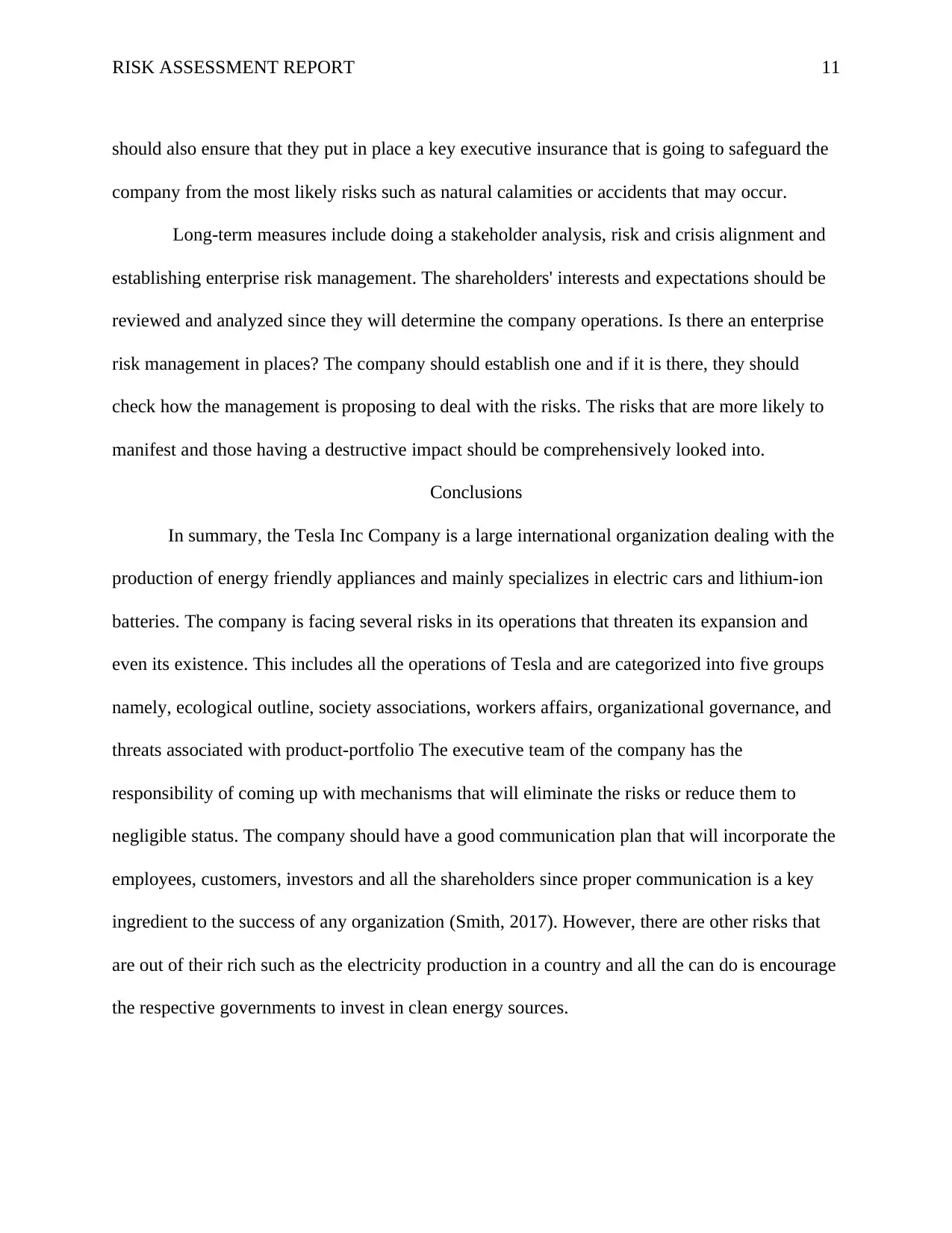
RISK ASSESSMENT REPORT 11
should also ensure that they put in place a key executive insurance that is going to safeguard the
company from the most likely risks such as natural calamities or accidents that may occur.
Long-term measures include doing a stakeholder analysis, risk and crisis alignment and
establishing enterprise risk management. The shareholders' interests and expectations should be
reviewed and analyzed since they will determine the company operations. Is there an enterprise
risk management in places? The company should establish one and if it is there, they should
check how the management is proposing to deal with the risks. The risks that are more likely to
manifest and those having a destructive impact should be comprehensively looked into.
Conclusions
In summary, the Tesla Inc Company is a large international organization dealing with the
production of energy friendly appliances and mainly specializes in electric cars and lithium-ion
batteries. The company is facing several risks in its operations that threaten its expansion and
even its existence. This includes all the operations of Tesla and are categorized into five groups
namely, ecological outline, society associations, workers affairs, organizational governance, and
threats associated with product-portfolio The executive team of the company has the
responsibility of coming up with mechanisms that will eliminate the risks or reduce them to
negligible status. The company should have a good communication plan that will incorporate the
employees, customers, investors and all the shareholders since proper communication is a key
ingredient to the success of any organization (Smith, 2017). However, there are other risks that
are out of their rich such as the electricity production in a country and all the can do is encourage
the respective governments to invest in clean energy sources.
should also ensure that they put in place a key executive insurance that is going to safeguard the
company from the most likely risks such as natural calamities or accidents that may occur.
Long-term measures include doing a stakeholder analysis, risk and crisis alignment and
establishing enterprise risk management. The shareholders' interests and expectations should be
reviewed and analyzed since they will determine the company operations. Is there an enterprise
risk management in places? The company should establish one and if it is there, they should
check how the management is proposing to deal with the risks. The risks that are more likely to
manifest and those having a destructive impact should be comprehensively looked into.
Conclusions
In summary, the Tesla Inc Company is a large international organization dealing with the
production of energy friendly appliances and mainly specializes in electric cars and lithium-ion
batteries. The company is facing several risks in its operations that threaten its expansion and
even its existence. This includes all the operations of Tesla and are categorized into five groups
namely, ecological outline, society associations, workers affairs, organizational governance, and
threats associated with product-portfolio The executive team of the company has the
responsibility of coming up with mechanisms that will eliminate the risks or reduce them to
negligible status. The company should have a good communication plan that will incorporate the
employees, customers, investors and all the shareholders since proper communication is a key
ingredient to the success of any organization (Smith, 2017). However, there are other risks that
are out of their rich such as the electricity production in a country and all the can do is encourage
the respective governments to invest in clean energy sources.
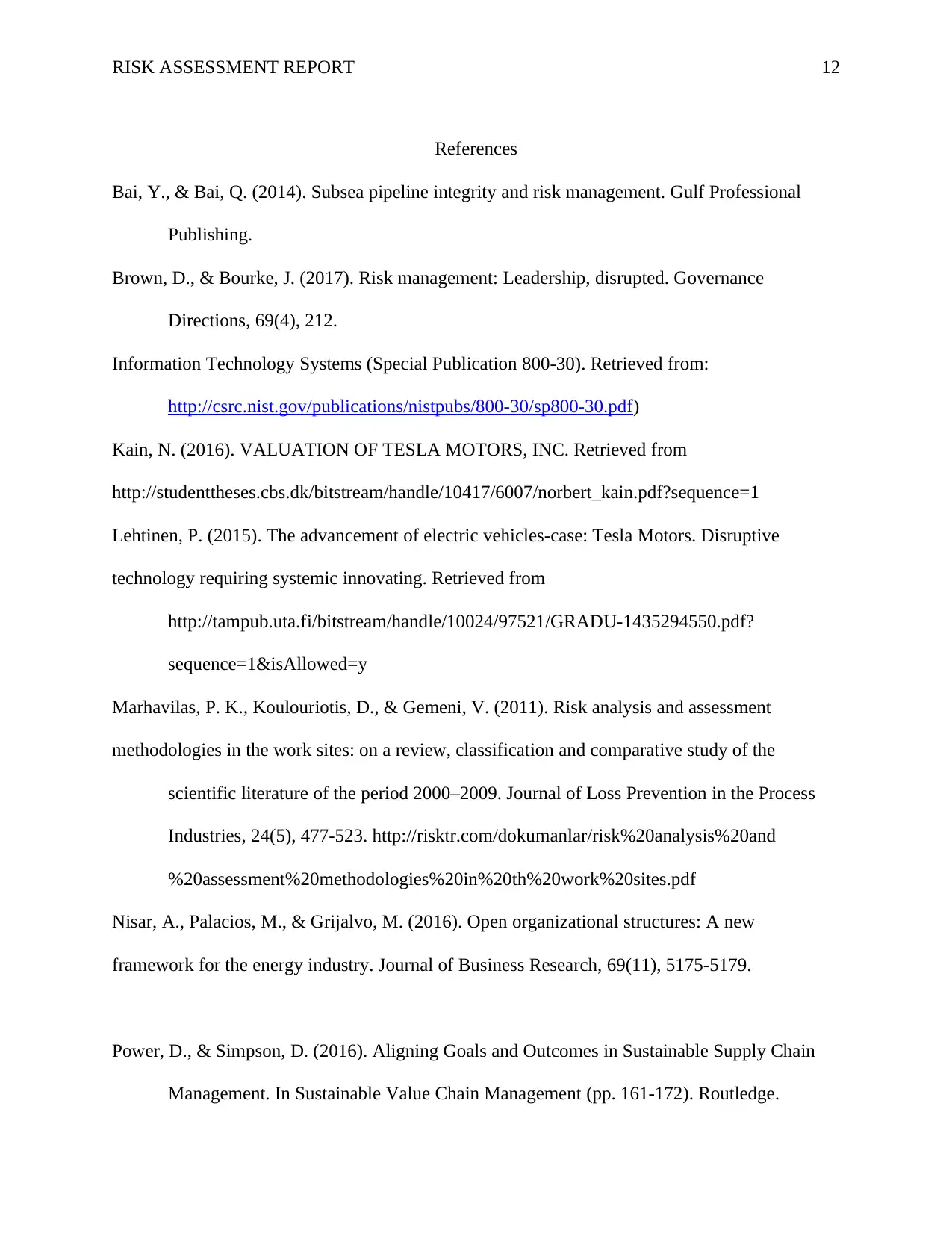
RISK ASSESSMENT REPORT 12
References
Bai, Y., & Bai, Q. (2014). Subsea pipeline integrity and risk management. Gulf Professional
Publishing.
Brown, D., & Bourke, J. (2017). Risk management: Leadership, disrupted. Governance
Directions, 69(4), 212.
Information Technology Systems (Special Publication 800-30). Retrieved from:
http://csrc.nist.gov/publications/nistpubs/800-30/sp800-30.pdf)
Kain, N. (2016). VALUATION OF TESLA MOTORS, INC. Retrieved from
http://studenttheses.cbs.dk/bitstream/handle/10417/6007/norbert_kain.pdf?sequence=1
Lehtinen, P. (2015). The advancement of electric vehicles-case: Tesla Motors. Disruptive
technology requiring systemic innovating. Retrieved from
http://tampub.uta.fi/bitstream/handle/10024/97521/GRADU-1435294550.pdf?
sequence=1&isAllowed=y
Marhavilas, P. K., Koulouriotis, D., & Gemeni, V. (2011). Risk analysis and assessment
methodologies in the work sites: on a review, classification and comparative study of the
scientific literature of the period 2000–2009. Journal of Loss Prevention in the Process
Industries, 24(5), 477-523. http://risktr.com/dokumanlar/risk%20analysis%20and
%20assessment%20methodologies%20in%20th%20work%20sites.pdf
Nisar, A., Palacios, M., & Grijalvo, M. (2016). Open organizational structures: A new
framework for the energy industry. Journal of Business Research, 69(11), 5175-5179.
Power, D., & Simpson, D. (2016). Aligning Goals and Outcomes in Sustainable Supply Chain
Management. In Sustainable Value Chain Management (pp. 161-172). Routledge.
References
Bai, Y., & Bai, Q. (2014). Subsea pipeline integrity and risk management. Gulf Professional
Publishing.
Brown, D., & Bourke, J. (2017). Risk management: Leadership, disrupted. Governance
Directions, 69(4), 212.
Information Technology Systems (Special Publication 800-30). Retrieved from:
http://csrc.nist.gov/publications/nistpubs/800-30/sp800-30.pdf)
Kain, N. (2016). VALUATION OF TESLA MOTORS, INC. Retrieved from
http://studenttheses.cbs.dk/bitstream/handle/10417/6007/norbert_kain.pdf?sequence=1
Lehtinen, P. (2015). The advancement of electric vehicles-case: Tesla Motors. Disruptive
technology requiring systemic innovating. Retrieved from
http://tampub.uta.fi/bitstream/handle/10024/97521/GRADU-1435294550.pdf?
sequence=1&isAllowed=y
Marhavilas, P. K., Koulouriotis, D., & Gemeni, V. (2011). Risk analysis and assessment
methodologies in the work sites: on a review, classification and comparative study of the
scientific literature of the period 2000–2009. Journal of Loss Prevention in the Process
Industries, 24(5), 477-523. http://risktr.com/dokumanlar/risk%20analysis%20and
%20assessment%20methodologies%20in%20th%20work%20sites.pdf
Nisar, A., Palacios, M., & Grijalvo, M. (2016). Open organizational structures: A new
framework for the energy industry. Journal of Business Research, 69(11), 5175-5179.
Power, D., & Simpson, D. (2016). Aligning Goals and Outcomes in Sustainable Supply Chain
Management. In Sustainable Value Chain Management (pp. 161-172). Routledge.
⊘ This is a preview!⊘
Do you want full access?
Subscribe today to unlock all pages.

Trusted by 1+ million students worldwide
1 out of 13
Related Documents
Your All-in-One AI-Powered Toolkit for Academic Success.
+13062052269
info@desklib.com
Available 24*7 on WhatsApp / Email
![[object Object]](/_next/static/media/star-bottom.7253800d.svg)
Unlock your academic potential
Copyright © 2020–2025 A2Z Services. All Rights Reserved. Developed and managed by ZUCOL.





